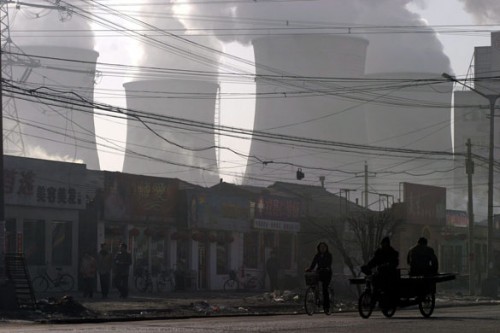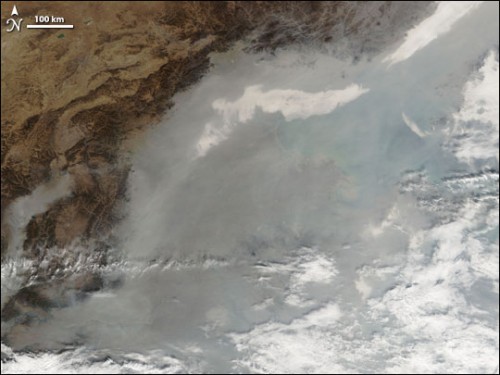
Between 2000 and 2007, carbon emissions from fossil fuel combustion worldwide increased 22 percent to an estimated 8.2 billion tons, according to the latest Vital Signs Update released by the Worldwatch Institute. China accounted for a staggering 57 percent of the growth in emissions during this period, while India contributed 8 percent and the United States and Europe contributed 4 and 3 percent, respectively.
Despite the dramatic rise in China’s fossil fuel emissions, the United States is still the leading emitter of carbon dioxide (CO2) from fossil fuels. Americans still outpace the Chinese more than 4 to 1 in terms of per-capita emissions (your average peasant farmer in China is not going to use near as much energy as your average American, there are just more of them), and they outpace Indians more than 13 to 1 and Africans 18 to 1. Nevertheless, the rapid, coal-dependent development of China has become the most important driver of current growth in global CO2 emissions. Coal provides 70 percent of commercial energy in China and 56 percent in India.
The combustion of fossil fuels, primarily coal, oil, and natural gas, accounts for about 74 percent of all CO2 emissions and for roughly 57 percent of all greenhouse gas emissions globally.
In December 2009, the parties to the United Nations Framework Convention on Climate Change intend to reach agreement on a new climate change protocol to limit carbon emissions, building on the Kyoto Protocol originally signed in 1997 (and still largely ignored by our current administration). The question of how emissions from China and other rapidly growing developing countries will be regulated in this new agreement is one of the most contentious issues that negotiators must navigate before the agreement can be reached.
“Industrial countries are largely responsible for the global climate crisis the world now faces,†said Christopher Flavin, President of the Worldwatch Institute. “But recent emissions trends demonstrate that it will require an active partnership between industrial and developing countries if the climate is to be stabilized.†Or in other words, we got the world into this mess with our lavish lifestyles, but would rather regulate the way developing countries do things rather than reduce emissions at home. Only through the combined efforts of reduction of per-capita emissions in the “developed” world, and rapid adoption of renewable energy in the “developing” world will we be able to overcome this problem.
Recently China has been doing everything (even controlling the weather) in order to clean up the smog in Beijing in time for the Summer Olympics. With events starting last week, scientists have been given a once-in-a-lifetime opportunity to observe how the atmosphere responds when a heavily populated region substantially curbs everyday industrial emissions.
The National Science Foundation (NSF)-funded “Cheju ABC Plume-Monsoon Experiment” (CAPMEX) will include a series of flights by specially equipped unmanned aircraft known as autonomous unmanned aerial vehicles (AUAVs).
The aerial vehicles were developed by Advanced Ceramics. Instruments on the aircraft can measure smog and its effects on meteorological conditions.

Data-gathering flights will originate at the South Korean island of Cheju, located about 1,165 kilometers (725 miles) southeast of Beijing. Cheju is in the projected path of pollution plumes that begin in various cities in China, including the capital.
Information from the flights will be combined with measurements by satellites and observatories on the ground that will track dust, soot and other pollution aerosols that travel from Beijing and other parts of China in so-called atmospheric brown clouds.
The instruments will observe pollution transport patterns as Beijing enacts its “great shutdown” for the Summer Olympic Games. Chinese officials have reduced industrial activity by as much as 30 percent and mandated cuts in automobile use by half, to safeguard the health of competing athletes immediately before and during the games.
“Thanks to the concern of Olympic organizers, the Chinese government, and the cooperation of the Korean government, we have a huge and unprecedented opportunity to observe a large reduction in everyday emissions from a region that’s very industrially active,” said atmospheric scientist V. Ramanathan of Scripps Institution of Oceanography (SIO), the lead investigator of CAPMEX.
“CAPMEX will be the very first UAV campaign in east Asia for air pollution and cloud interaction studies,” added CAPMEX field campaign co-lead investigator Soon-Chang Yoon, a researcher at the School of Earth and Environmental Sciences at Seoul National University in Korea. “This will be a very interesting experiment that can never happen again.”
“Ramanathan’s earlier research on atmospheric brown clouds demonstrated their importance in the polluted regions of the atmosphere,” said Jay Fein, NSF program director for climate dynamics. “CAPMEX takes this work an important step forward with new micro- and nano-sensor technologies. These technologies will provide new estimates of solar irradiance, aerosol-cloud interactions, climate forcing and important components of the biogeochemical cycles of the East Asian and western Pacific Ocean region.”
Satellite and ground observations began on August 1. Pre-inspection test flights are started August 9, with the field campaign expected to run through September 30.
“Black carbon in soot is a major contributor to global warming,” said Ramanathan. “By determining the effects of soot reductions during the Olympics on atmospheric heating, we can gain much needed insights into the magnitude of future global warming.”
Ramanathan’s team has revolutionized the gathering of atmospheric data through the use of AUAVs that enable researchers to form dimensional profiles of clouds and other atmospheric masses at relatively low cost.
In previous studies, meteorological data gathered by the aircraft helped demonstrate that atmospheric brown clouds can diminish the solar radiation that reaches Earth’s surface, warm the atmosphere at low altitudes and disrupt cloud formation.
With CAPMEX, scientists hope to improve their ability to deliver such assessments of particulate pollution effects more rapidly and enhance their value as a policymaking tool.
Miniaturized instruments on the aircraft measure a range of properties such as the quantity of soot and size of the aerosols upon which cloud droplets form. The instruments also record variables such as temperature, humidity and the intensity of sunlight that permeates clouds and masses of smog.
For CAPMEX, photonics instruments will be added to the aircrafts’ payloads to help calculate the specific contributions of various aerosols to atmospheric heating.
Other new instruments such as auto-leveling platforms will enable researchers to improve estimates of how much dimming of sunlight takes place at the ocean surface because of pollution aerosols in the atmosphere.
What strikes me most about these issues is that we are treating the one and only planet we have like a giant science experiment. Will be end up killing ourselves off, or wont we? Lets just build a bunch of coal burning power plants and find out! Renewable energy or bust!
You state that Chinese “Residents are frequently warned to spend as little time as possible outdoors, due to the air pollution ” I can never recall a time when I could not go outside, in the US, due to high pollution levels. I am neither a scientist nor a “stupid American” , but this is proof positive to me that China has more pollution than the US. Pretty simple actually.
American industry has been forced to regulate particulate pollution (soot, etc), but has done nothing to regulate it’s co2 emissions. And there have been many days here in boston where they recommend elderly, people with asthma and children not go outside. The same is true for LA, Detroit, New York, and any other major city in America.